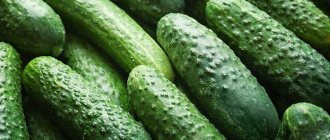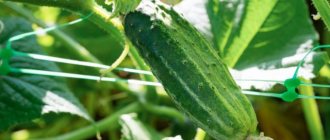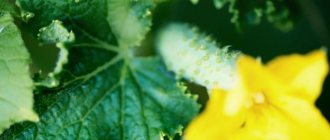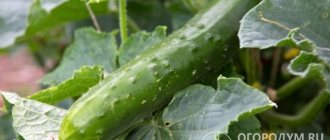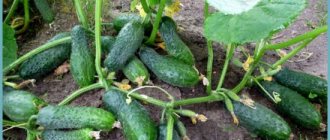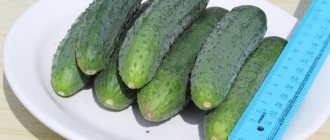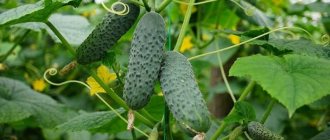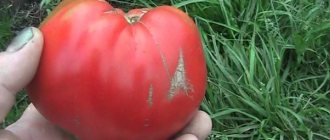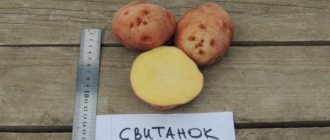Description of the variety Claudine F1
Cucumbers Claudine F1 are an early hybrid of the parthenocarpic type. To ripen, cucumbers need approximately 38-40 days from the moment of germination. The hybrid was created by Dutch breeders from Monsanto. It was included in the Russian state register in 2008. The crop is suitable for growing in open ground, greenhouses, and greenhouses.
The bush is indeterminate, medium in height. It produces a lot of foliage, it grows thickly, sometimes covering the fruits from the sun. So it may be necessary to trim off all excess leaves so that the bush is well lit and warmed up from all sides. The leaves themselves are medium in size and bright green. Female type flowers.
Greens are cylindrical, dark green, finely tuberous, with thin skin and white prickly spines
The ovaries are formed in bunches. Each node can have up to 7 cucumbers. The fruits are medium-sized, weighing 85-100 g and 10-11 cm long. The greens are cylindrical, dark green, finely tuberous, with a thin skin and white prickly spines. The pulp is dense, light, and no voids are formed in it. The taste is fresh, sweetish, without bitterness.
Important!
Claudine F1 cucumbers do not require pollination by bees for normal fruiting. So, both in greenhouses and in open ground, they give maximum yield with proper care.
Deciding on a variety for different regions of Russia
When obtaining new varieties, breeders focus not only on the properties of the plant itself, but also on the characteristics and possibilities of cultivation in a particular place. Temperature, light, humidity and the most common diseases and pests are taken into account. It is useful to choose cucumber varieties based on the region.
The best varieties of the Moscow region
Moscow summer residents are not deprived of the care of breeders. There are many varieties for this region - Murashka F1, Vyaznikovsky 37, Vir 505, Petersburg Express F1. Let's take a closer look at some of them.
State Farm
A convenient, proven variety that produces a stable harvest. It is well stored and transported; farmers love it, as it can be collected with agricultural machinery. Fruit weight is 120-160 grams, color is dark green, tubercles are infrequent.
Look F1
The greens are dark in color, covered with sparse tubercles, grow up to 9-12 centimeters, weigh up to 115 grams. Even with scanty watering, they do not acquire a bitter taste and remain sweet and fragrant.
Vzglyad cucumbers ripen quickly and easily (45-47 days), and are good fresh and in the form of pickles. They do not deteriorate during transportation.
Movir 1 F1
The variety is intended for fresh consumption. Sings together, on the 57th day from germination. The fruit is large - 4.5-5.5 centimeters in diameter (triangular), size - up to 12 centimeters, weight - 90-130 grams.
It is weakly resistant to diseases; 4.5-7.4 kilograms of cucumbers are harvested from one plant.
Frost-resistant, for the Urals and Siberia
For cultivation in these regions, mainly varieties are used that can withstand sudden cold snaps and do not require high temperatures. Only those species that ripen quickly are suitable, since the summer is short.
Nezhinsky
Cucumbers grow up to 100 grams, the yield is up to 2 kilograms per square meter. Pollinated by bees. The fruits appear 2 months after germination. It withstands heat and short droughts well. There are many bumps on the skin with black spikes, the green spots are ovoid.
Nezhinsky became the basis of many varieties. It is considered strong and unpretentious. Despite the constant emergence of new species, it is widely in demand in the seed market.
Bush
The variety has been known since 1975. Always loved by gardeners. Many people have been receiving seeds from their cucumbers for years.
The skin is tender, the bitterness is insignificant. The size of the fruit is 8-10 centimeters, weight – up to 100 grams. Suitability for pickling is limited. It is unpretentious to grow, but produces a small harvest.
Competitor
It has a quality that is in demand in cold regions - it ripens in 45-50 days. Pollination - by bees. The plant bears fruit for up to 90 days under favorable conditions. The fruits weigh up to 130 grams and grow up to 13 centimeters.
The competitor is not bitter, has a sweetish pulp with a good fresh smell. Delicious fresh or canned. Easy to assemble due to the long leg. Unpretentious and resistant to diseases.
Altaic
Belongs to varieties with high resistance to frost. The fruits appear in mid-June. Well transported and stored.
Cucumbers are bright green, weight – 85-110 grams. The skin is dense, with a small number of bumps. The fruiting period is short, it requires warmth for growth. Altai varieties are well suited for pickling.
Serpentine
Medium-sized cucumbers are light green in color with small stripes and weak fluff. Easily survives frosts. They do not turn yellow and are not bitter. Small fruits – 8-10 centimeters, weighing 70-80 grams.
It ripens quickly and does not suffer from pumpkin diseases. Serpentine grows well in greenhouses and in the garden, the harvest is 4-6 kilograms. Delicious fresh or canned.
Everyone in our country loves cucumbers. They are grown in summer cottages, on balconies and in apartments. Breeders constantly delight gardeners with new varieties that have improved taste characteristics and increased resistance to adverse conditions. The task of summer residents is not to get lost in this diversity and choose the right variety.
Characteristics of cucumbers Claudine F1
Also check out these articles
- Bee packages and their types
- Radish pests
- Apple jam for the winter
- Soybean meal
Many experts consider Claudine F1 one of the best hybrids. But what is special about these cucumbers:
- You can harvest 9-10 kg of cucumbers per square meter per season. High yields are achieved largely due to the fact that the variety is parthenocarpic.
- The harvested crop is suitable for long-term transportation. On the road, the greens do not wrinkle or spoil if they are collected in time.
- Product quality is high. The cucumbers are very beautiful, one to one, dense, can be stored for a long time, and have a pleasant taste and aroma.
- There is immunity to powdery mildew and cucumber mosaic virus.
The pulp is dense, light, without voids, the taste is fresh, sweetish, without bitterness
- The bush of this hybrid is unpretentious to the location and growing conditions.
- Hybrid for salad purposes.
Important!
Cucumber Claudine F1 belongs to the first generation hybrids. This means that seeds collected from a grown crop cannot be used for sowing next year. They do not have maternal qualities, so they may not even germinate or simply will not produce a harvest!
Basic indicators
The variety is characterized by long-term fertility, high yield, up to 10 kg per m2.
Increased productivity is facilitated by:
- good seed material (seeds);
- fertile, well-fertilized soil;
- creating favorable growing conditions, sorting;
- watering, weeding, loosening;
- replenishment with basic mineral and organic fertilizers and periodic fertilizing;
- frequent harvesting.
The volume of cucumbers can be 2-3 times greater than that of other varieties due to early ripening during the season (about 40 days). In greenhouse conditions much more is harvested.
Before purchasing, gardeners, especially for the first time, try to become familiar with the advantages and disadvantages of a variety.
Positive sides:
- high temperature does not harm plants;
- early ripeness and high yield of fruits as a result of cultivation;
- when overripe, the shape remains the same;
- does not require pollination;
- not demanding in care;
- stored for two weeks;
- no bitterness;
- female type of inflorescence;
- type of fruit – gherkins;
- resistance to a range of diseases and insect pests.
Disadvantages: it is better not to replant the plant. Quite a significant cost of seeds.
Note!
The Claudine F1 variety is self-pollinating and does not require the presence of insects (bees).
Rules for planting cucumber seedlings
You can grow cucumber Claudine F1 by seedlings or by sowing. If planting cucumbers is carried out using the seedling method, it is necessary to sow the seeds in cups about a month before transplanting the seedlings to a permanent place. Transplanting to the garden is done in early June, so sowing seedlings is done in early May or a little earlier.
Seedlings are grown immediately in 0.5 liter peat cups. The soil for sowing is taken loose and fertilized. It can be made from 2 parts peat, 1 part sawdust with sand, and 1 part earth. To disinfect the soil, you need to mix it in a container and pour it with a dark pink solution of potassium permanganate.
Containers for planting seeds are filled with soil and seeds are placed in it to a depth of 2 cm. Peat can be sprinkled on top with a layer of 1 cm, but not necessarily. After this, you can move the pots to a dark place and cover them with transparent film to create greenhouse conditions for the seeds. When shoots appear, the film is removed and the containers are transferred to a bright windowsill.
The planting level should be the same as in pots
You need to water the seedlings with settled water at room temperature about once a week. Kemira is used as fertilizer, but only if the seedlings begin to wither. The seedlings need to be transplanted to a permanent place after the appearance of 2-3 developed leaves.
Before planting, the area is dug up and fertilized with humus (you can use the NPK mineral complex according to the instructions). Then they make holes for seedlings and plant cucumbers. They cannot be deepened too much. The planting level should be the same as in pots. It is recommended not to try to remove seedlings from pots, but to plant them in pots so as not to injure the roots. This is why it is worth using peat or paper cups for planting. After planting, the soil is watered and the seedlings should be left for a couple of weeks so that they take root normally.
Important!
Hybrid seeds are usually treated with growth stimulants and disease protectants, so they cannot be washed before sowing.
Features of agricultural technology
Claudine F1 is grown in any conditions. Plants are cultivated in greenhouses. Cover with foil overnight in open ground.
Preparation of liquid org. fertilizers at home:
- A large tank is placed outside on the sunny side and filled with bird droppings.
- Water is poured over the bird droppings and should not overflow.
- Close this tank with a lid.
Water is poured in for the purpose of fermentation. The water and droppings are mixed with a long, strong stick, releasing CO2 bubbles. The solution of litter and water is left for 1-2 weeks.
Good soil:
- Loams – contains clay, sand.
- Black in color, rich in humus, non-stratified, homogeneous calcareous, loamy-sandy, rich in potassium (chernozem).
- Light, loose, containing humus, rich in carbonate (serozem).
Planting pattern 50x30 cm, sowing depth 2-3 m. Grown in greenhouses, greenhouses, greenhouses, insulated soils in spring and summer. The soil is fertilized two weeks before sowing. It is necessary to feed about 5 times per season.
Hilling strengthens the roots and forms new roots. It must be done carefully so as not to create mechanical injuries.
Sowing method of growing cucumbers
We recommend reading our other articles
- How often and how to water flowers correctly
- Onion variety Sturon
- Cucumber lecho for the winter
- Schefflera - care and reproduction
Direct sowing is carried out in the ground around the end of May or early June.
Direct sowing is carried out in the ground around the end of May or early June. It is important that by the time of planting the earth warms up to +8 degrees, and the air to +10. The land for sowing must be prepared approximately 1-2 weeks in advance. Per square meter of land take 20 g of ammonium nitrate, 30 g of superphosphate, 15 g of potassium sulfate. After this, the soil is dug up and loosened.
The seeds are placed in the holes at a distance of 30 cm from each other. Leave approximately 50 cm of free space between the rows. The sowing depth of the seeds is 2-3 cm. If the nights are still cold, it is worth covering the plantings with white agrofibre to protect them from freezing.
Important!
Seeds should be sown only in moist soil. Then they will germinate faster.
Caring for cucumbers Claudine F1
Cucumber Claudine F1 needs simple care. He has no special requirements. But this does not mean that you can plant cucumbers and simply harvest as they appear. Basic care rules must be followed.
- At the initial stage of cultivation, it is recommended to remove all weak shoots. In their place, you can plant healthy seedlings or sow new seeds.
- Watering is carried out as needed. It is very important that the soil has time to dry out, but not dry out. Water the cucumbers generously so that the soil is well saturated. Do not forget that a lack of water can negatively affect the taste.
Under the bushes it is necessary to regularly remove weeds or mulch the soil
- Under the bushes it is necessary to regularly remove weeds or mulch the soil. This is done to prevent diseases from growing in the area; besides, weeds take away nutrients from the bushes.
- It is necessary to form bushes. All flowers and shoots are removed from the first axils. In the axil of 5 leaves you need to leave 1 ovary. In the axil, 7-10 leaves are left with 2 ovaries. When the bush reaches a meter in height, you can pinch the top to prolong the fruiting of the bush.
Interesting!
From mid-August you can start hilling the bushes. This will cause the development of lateral roots from the stem, and will extend the harvest period.
- The hybrid responds well to the addition of organic matter and minerals (nitrogen, potassium, phosphorus) to the soil. When growth is delayed, nitrogen is added, and during flowering and the appearance of ovaries - potassium and phosphorus. But an infusion of wood ash, which is made from 10 liters of water and 300 g of wood ash, can be sprayed on the bushes throughout the season.
Proper care allows cucumbers to develop properly. Thanks to this, the yield of the bushes increases.
Nuances of cultivation and possible difficulties
Hybrid Claudine f1 is called an improved form of cucumber Claudia f1. The culture is easy to care for and resistant to heat and cold.
Like any other bunch-type cucumber, the plant needs proper shaping of the bushes:
- All shoots and flowers are removed from the leaf axils;
- one ovary is left in the axil of the fifth leaf;
- in the axils of 7-10 leaves, two ovaries are left;
- the stem is thrown over the trellis;
- The top of the head is pinched 1 m from the ground.
This procedure is called "blinding". It is carried out with the aim of extending the fruiting period and improving disease resistance.
Description, planting and care of winged euonymus, its use in landscape design
From mid-August, the bushes are earthed up to stimulate the growth of new roots. For replenishment use: whey 1 liter and iodine 25-30 drops, boric acid solution (10 g/10 liters of hot water).
Diseases and pests of cucumbers
Fungicides are used to control diseases
Hybrid Claudine F1 has good immunity to powdery mildew and cucumber mosaic virus, but it can still get sick if you don’t care for it properly. Signs of the appearance of diseases can be yellowing and drying out of foliage, the appearance of strange spots on leaves, pagons, and inhibition of development. To combat diseases, fungicides such as Fitosporin, Bordeaux mixture, and Oxychoma are used. From folk remedies, at the initial stage of damage, a solution of potassium permanganate, whey, ash, and iodine can help.
If the bushes are attacked by pests (aphids, whiteflies, spider mites), you should get rid of them immediately. The insecticide “Aktara”, “Nemabactin”, “Fitoverm” or the like will help with this task. Among the folk remedies, wood ash, with pepper and mustard, which are used to crush the leaves, can repel pests. Traps or repellers will save the area from mole crickets.
Harvesting and processing
The harvest will be ready for harvesting approximately 40 days after the first cucumber shoots appear. Greens should be harvested immediately after ripening to prolong fruiting. But in principle, the fruits can hang on the bushes for a long time, they do not barrel, and retain their taste even when overripe.
Cucumbers are suitable for preparing fresh salads and summer snacks, but it is better not to use them for pickling
The harvest is recommended for fresh consumption. Cucumbers are suitable for preparing fresh salads and summer snacks. But it’s better not to take them for pickling. Due to their thin skin, they become very soft and the taste may deteriorate.
Interesting!
The harvested crop can be stored in a cool room or in the refrigerator for 2-3 weeks.
Advantages and disadvantages
Pros of these cucumbers:
- Fast ripening (harvest 39-40 days after sowing).
- Long fruiting period.
- Resistant to temperature changes.
- Easy care.
- Good keeping quality of cucumbers.
Flaws:
- Overripe cucumbers do not barrel, their shape remains the same (however, this characteristic is controversial, sometimes it is considered an advantage).
- The greens are prickly (this is clearly visible from the photo on the bag).
Reviews from gardeners about the cucumber variety Claudine F1
Gardeners love the Claudine F1 cucumber for its pleasant taste and ease of cultivation.
- Sofia Mirshavka : “I love Claudine F1 cucumbers. They grow quickly, even if you sow the seeds directly in the garden, they hardly get sick, and they produce large harvests. At one time I tried to grow them in a greenhouse, but the yield there was no higher, so now I only plant them in open ground. The harvest is not suitable for canning, but it is an excellent variety for eating. Cucumbers have a pleasant, refreshing taste, just what you need for summer salads!”
- Tatyana Sklyar : “I usually grow cucumbers using the seedling method, so they develop faster. I also grow Claudine F1 through seedlings. The sprouts turn out strong, with a thick stem, and do not break. Only 1-2 seedlings out of a dozen can be weak. After diving into open ground, they quickly take root. I harvest as soon as the cucumbers grow to 10 cm. While young, these cucumbers are very tasty!”
- Igor Veremey : “I’ve been planting Claudine F1 cucumber on my plot for several years now. Last year the bushes became sick with powdery mildew - I treated them with fungicides. The plants quickly recovered and gave a good harvest, but still less than on healthy bushes. The greens are beautiful, tasty in this hybrid, I like the fact that they have a thin skin and pleasant, juicy flesh; I have never noticed any bitterness.”
Care
Rules for caring for cucumbers:
- thinning seedlings and removing weak shoots;
- at the initial stage of the growing season, plants are watered once a week, from the moment of fruiting the frequency is increased to 3-4 times, 2.5-3 liters per 1 m²;
- after each watering, the soil is loosened and weeds are removed;
- if development is delayed, the bushes are fed with nitrogen-containing fertilizers;
- in addition to nitrogenous fertilizers, cucumbers are fertilized with organic matter, potassium and phosphorus;
- The harvest is harvested as the greens ripen to support abundant fruiting.

